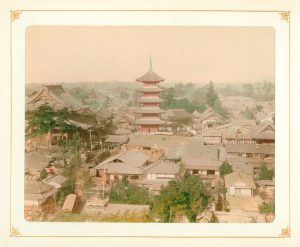“Tourists landing in Yokohama will find that [the Tokaido Railroad] furnishes the quickest way for reaching Kyoto. Starting in Tokyo it passes through the most populous towns on the eastern shore of Japan; giving many beautiful views of the sea coast, and Lake Biwa. Most will prefer to take trains that will allow them, to see Mt. Fuji by day-light…”
The Official Guidebook to Kyoto and the Allied Prefectures, 1895
Wright’s album of photographs is not arranged in accordance with the sequence of his travels in Japan, nor are the photographs generally grouped by location. After arriving in Yokohama, and staying in Tokyo, Wright traveled west by rail. The Tokaido railway had been established in 1889, and followed the route of the historic Tokaido Road. The city of Nagoya, where Wright photographed the Higashi Betsuin Temple, sits 160 miles west of Tokyo.


